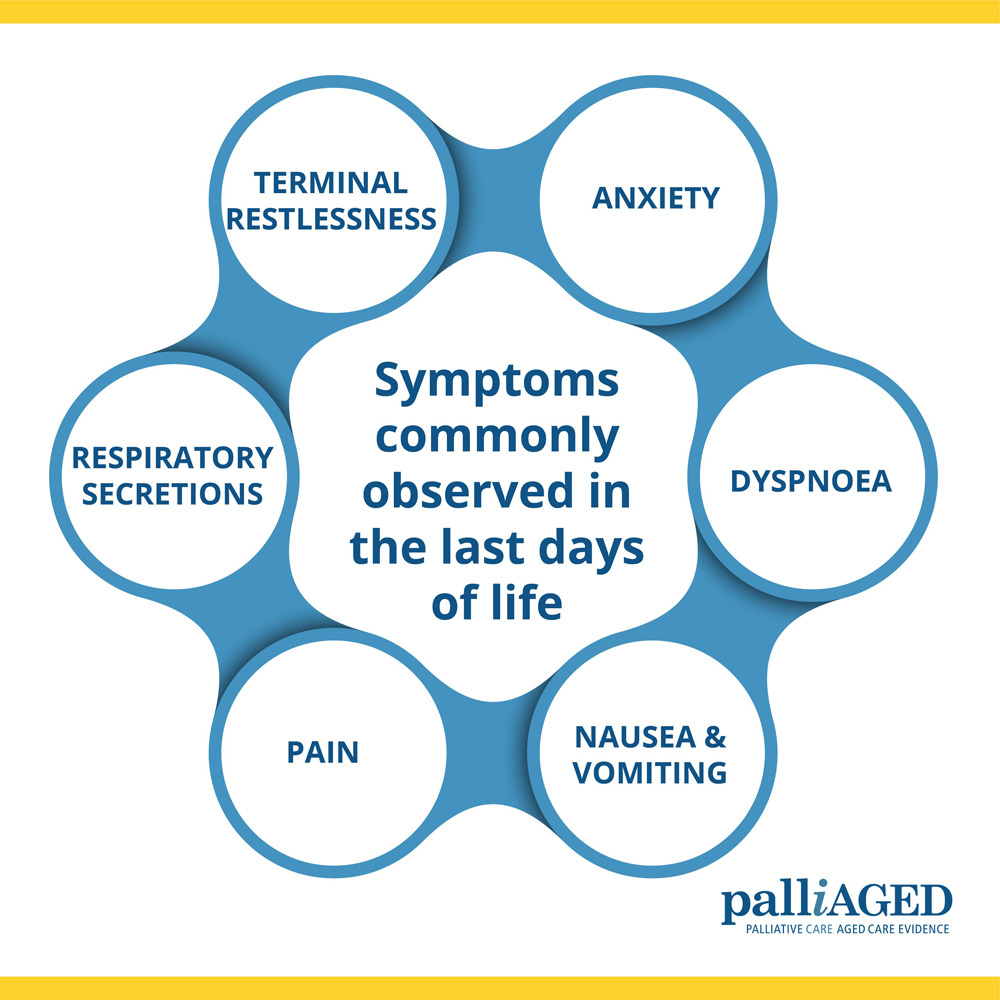 When palliAGED was launched in 2017, it included some content transferred from the Decision Assist website which was closed in the same year. This included a section on eight of the most common symptoms in palliative care (agitation, delirium, depression, dyspnoea / breathlessness, fatigue, nausea, noisy secretions, pain). This information was updated and expanded to create the palliAGED Symptoms and Medicines section including open access to free resources and information relating to Prescribing of Medication and Administering Medication.
When palliAGED was launched in 2017, it included some content transferred from the Decision Assist website which was closed in the same year. This included a section on eight of the most common symptoms in palliative care (agitation, delirium, depression, dyspnoea / breathlessness, fatigue, nausea, noisy secretions, pain). This information was updated and expanded to create the palliAGED Symptoms and Medicines section including open access to free resources and information relating to Prescribing of Medication and Administering Medication.
We regularly review our content to ensure that links are still working and that the resources we link to are, wherever possible, open and publicly accessible. In September 2018, changes in the availability of content were identified by our web team. This led to the review of the section not only in terms of possible replacement content but also an examination of the relevance and purpose of the section itself.
Reviewing Content
A review of Australian guidelines that may support prescribing at end of life was conducted. This ensured that content was meaningful in the Australian context. Using this information Paul Tait (Palliative Care Pharmacist) and Susan Gravier (Research Associate) reviewed the Symptoms and Medicines pages with a focus to:
- ensure the content matches the current evidence
- improve the linkages with the medicine management pages
- address care of older people in the last days of their life (terminal phase)
- improve the connectivity with the palliAGEDgp smartphone application, and
- continue to focus on providing open-access information (i.e. requires no subscription).
The proposed draft revision was then reviewed within CareSearch by Professor Jennifer Tieman and Dr Katrina Erny-Albrecht.
An invitation for external review was subsequently sent to nine people with specialist expertise or knowledge in the (Nurse Practitioners, GPs, pharmacists, Palliative Care Specialists). Review comments were received from:
- Dr David Healey, GP & member, Palliative Care for Older People Special Interest Group, Australia and New Zealand Society of Palliative Medicine Inc.
- Sandy Scholes, Consultant Pharmacist
- Prosper Sithole, Care Manager, Bupa Care Services.
Finalised Content
The original symptoms and medicines section included information on: agitation, dyspnoea, noisy secretions, delirium, fatigue, pain, depression, and nausea. In the updated pages, six symptoms are presented: Anxiety, Dyspnoea, Nausea and Vomiting, Pain, Respiratory Secretions, and Terminal Restlessness. These changes more clearly focus the symptoms in terms of their impact in the terminal phase.
The information relating to each symptom in the revised section is presented under the following headings: Principles, Prescribing Guidance, Useful Information, and Remember.
In the updated version, each symptoms page hosts a text box with links to the pages related to the elements of medicine management:
- Dysphagia
- Off-Label Prescribing
- Opioids: Switching Between Formulations
- Subcutaneous Medicine Administration.
The medicine management information has been consolidated and presented under the above four headings (previously Prescribing of Medicines, and Administering of Medicines).
Information under Prescribing Guidance has improved connectivity with the palliAGEDgp smartphone application.
Creating the Web Content
The palliAGED Symptoms and Medicines pages were updated based on the new content.
The entire section was moved to the palliAGED Practice Centre to consolidate practical resources in one location.
The revised Symptoms and Medicines pages were released in February 2019.
Page last updated 28 February 2019